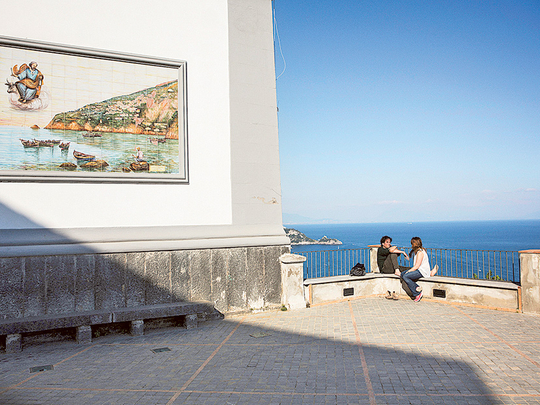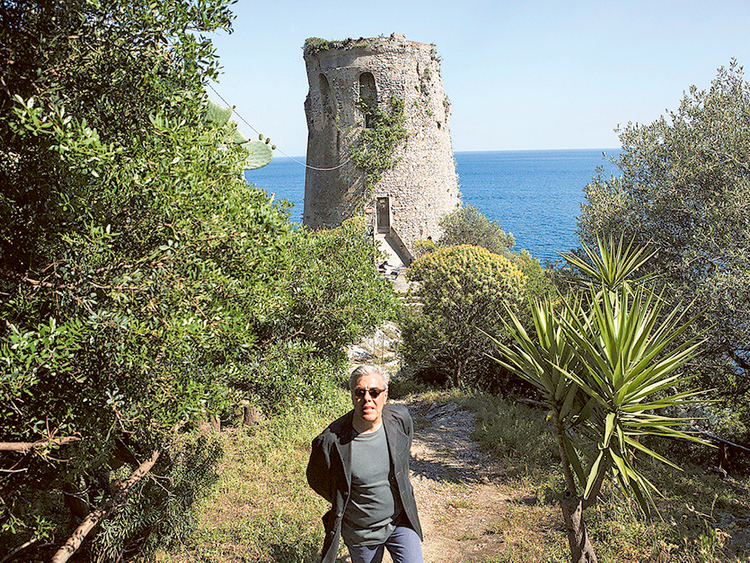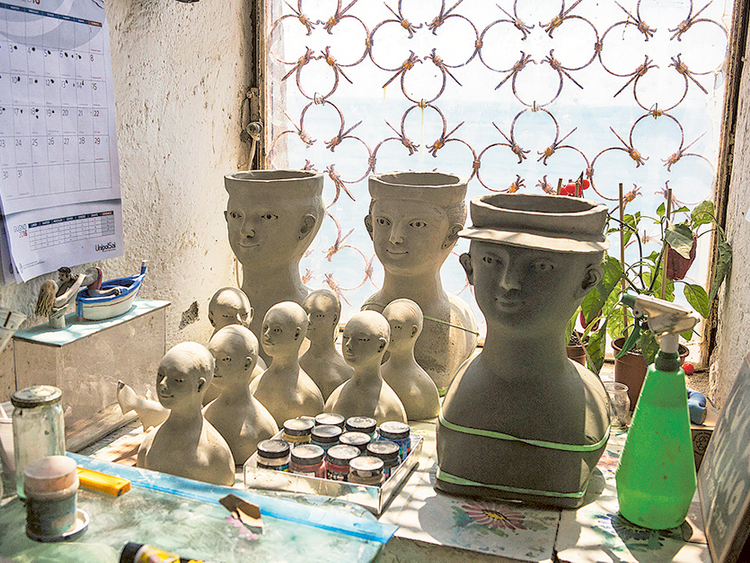
When tourists think of the Amalfi Coast, the stunning seaside towns of Positano and Amalfi usually come to mind. But Praiano, a small community hugging the cliffside between its famous neighbours, hopes to change that.
Praiano, a town of about 2,000 people, is not blessed with an alluring wide beachfront or an elegant seaside piazza where tourists can gather. The beach was the victim of a landslide 90 years ago, and the town sprawls instead along the coast’s steep cliffs.
Recently, residents unveiled a plan to lure visitors who want to take a break from the tourist-clogged areas of the coast. Called NaturArte Project, it lines Praiano’s streets with ceramic plaques and sculptures, creating a kind of open-air museum that unfolds along eight different routes. The inspiration, many of the planners say, was Antoni Gaudí’s Park Güell in Barcelona, Spain, though on a more subdued scale.
“We wanted to give a strong identity to the town and make it a final destination for visitors, not just a place they pass through,” said Roberto Pontecorvo, a board member of Agenda Praiano, a community association founded in 2013 to jump-start the town’s sense of civic responsibility and, hopefully, its economy.
Praiano is not a place to gawk at from the comfort of an air-conditioned bus. It must be savoured at a slow pace, if only because many of the itineraries require steep climbs up and down terraced slopes and alleyways, offering grand vistas of the coast as a prize. Residents boast that the town offers the most beautiful sunsets on the Amalfi Coast.
Like many towns along the coast, Praiano has a tradition of ceramic decorations, including a network of centuries-old small religious shrines made of majolica tiles.
Ceramic tiles are also used to mark street names and offer admonitions, such as picking up after one’s dog. In the large square in front of the town’s ceramic domed cathedral, a sign warns, “No soccer playing allowed”. But on a recent warm night, a group of young boys boisterously challenged the ban under a string of colourful lights.
The eight art itineraries, unveiled in May, follow the same zigzag pattern as the streets, with ceramic sculptures and panels inserted into the town’s rough stone walls at irregular intervals. Some Praianesi, as the locals are known, have added their own artistic touches to the walks.
Giuseppina De Rosa, who is retired, created a colourful raised garden of flowers and scented herbs — thyme, fiery chili peppers and wild fennel — along a narrow alley that borders one of the walks. The patch has become a tourist draw, she said, “perhaps because it’s so beautiful”.
The planners included artworks by eight artists with ties to the area. The pieces, 150 in total, were inspired by landscapes, traditions and mythology. After all, this is the area where Ulysses is said to have resisted the call of the Sirens, a theme several artists touched upon.
“The idea was to install these ceramics in such a beautiful place, where people built their homes and terraced gardens are inserted in nature,” said Patrizia Marchi, one of the artists. Her walk, which includes colourful masks of humans and animals, climbs from Praiano into woods that lead to a Dominican convent. “It seems like a magical site.”
Paolo Sandulli, a ceramist and sculptor, instead focused on capturing the spirit of the fishermen who once provided the bulk of the town’s economy, before tourism became a more prosperous alternative for many families.
“I wanted to recount that old world of the sea,” keeping the memory of long-gone fishermen alive, said Sandulli, who works out of an old tower on the beach.
Sandulli’s seven terra-cotta panels line a walking path that leads to Marina di Praia beach, a pebbly stretch wedged between the cliffsides.
The path, known as the Via Terramare, was built in the 1950s, and with it came Praiano’s first restaurants and hotels, as well as the Africana Famous Club, a seafront nightclub that helped define the dolce vita back then and where people still go to dance.
On a recent afternoon, a man with a wheelbarrow laden with cases of wine walked down the path, sweating in the hot sun.
“Down here, they transport everything by hand,” Sandulli said.
The idea for the project began with a small group of Praianesi who contributed their cash and time. Along with the town’s City Hall, the association received a €250,000 grant (Dh1 million) from the European Union, one of 31 projects funded in the Campania region.
While increasing tourism was the central goal, the group also wanted to get more residents involved. Building up social capital was important to the project’s long-term viability, they said. Most Praiano residents work in tourism-related businesses in other towns along the coast, something the planners hope to change.
In preparation for the inauguration of the itineraries in late May, for example, a group of dedicated residents spruced up the streets, whitewashing graffiti, burying open cable lines and fixing town signs.
Two software engineers from Calabria who fell in love with the project joined the association and developed a website and its free app. The owners of the homes where the ceramic panels were placed were asked to be responsible for their upkeep.
Giovanni Di Martino, Praiano’s mayor, said his administration had adopted the association’s plan and broadened it to include the restoration of religious shrines.
The request for funding from the European Union also included the restoration of 15th-century frescoes in a local convent and the recovery of the walking paths that link Praiano to the “Path of the Gods”, a spectacular if physically challenging footpath high along the coast from the town of Agerola to Praiano.
“We tried to involve the entire town around a broader notion of tourism whereby even the corner of a small house can be an element of discovery,” the mayor said.
Luigi Zingales, an economist at the University of Chicago Booth School of Business, who helped draft the social capital model for the association, said there is a political context as well.
“Seen from the outside, this may not seem like a big achievement,” he said. “But in the south, where there is no tradition of doing things from the bottom up, it shows that you can actually do things with public funding, but without being connected” to politicians or interests.
“It’s a small step for Praiano but a leap forward for southern Italy,” he added.
So far, the local reaction has been a mix of scepticism and pride, as dozens turned out for the project’s inauguration.
“There is still much work to be done,” said Raffaele Cuccurullo, the town’s council member responsible for tourism. “There are still people who are convinced that we don’t live off tourism, so they don’t care if the town is dirty.”
Yet Cuccurullo, who is also a carpenter, sounded an optimistic note, saying work orders had increased as more local homes were transformed into bed-and-breakfasts or vacation homes.
“The more people come, the more activities will open, such as restaurants and bars,” he said.
Pontecorvo, the board member of Agenda Praiano, offered a different goal.
“We needed to get locals to believe in their own town,” he said.
–New York Times News Service













